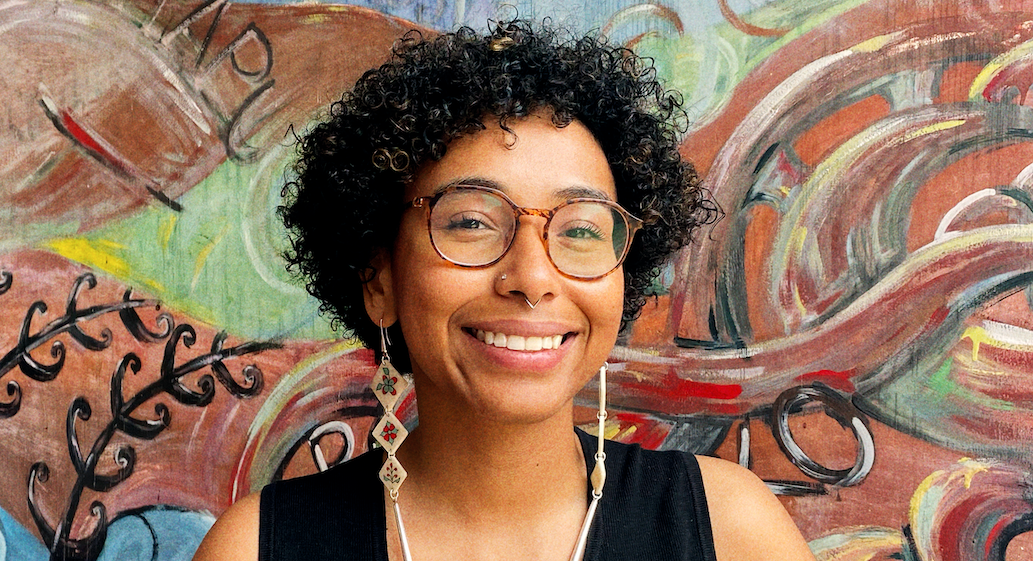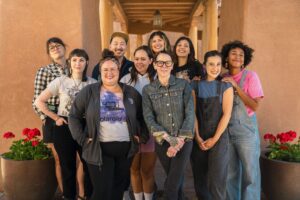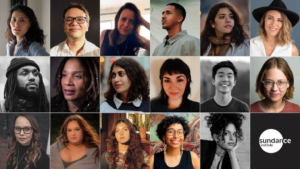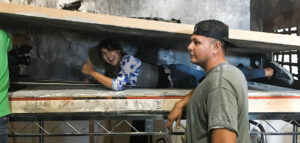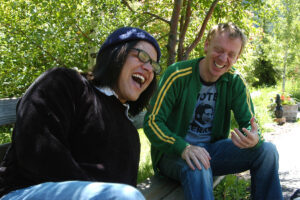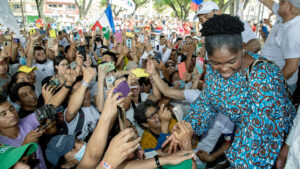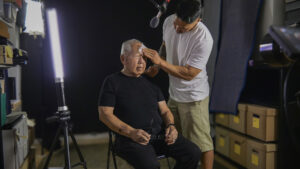By Adam Piron
In celebration of Indigenous People’s Day, Indigenous Program Director, Adam Piron, spoke with Anpa’o Locke (Hunkpapha Lakota and Ahtna Dené) about her latest short film, Kawá — and the impact of the creative process.
Anpa’o Locke is an Afro-Indigenous writer, filmmaker, and curator, who is Hunkpapha Lakota and Ahtna Dené, born in the Standing Rock Nation. She is a 2023 Sundance Native Lab Fellow, and was also a 2022 Indigenous Program Full Circle Fellow. Anpa’o’s focus within filmmaking is on the Native diaspora experience with sovereignty and self-determination as modes for empowered storytelling. She received her BA in Film Studies from Mount Holyoke College. She currently resides in Tiwa territory in Albuquerque, New Mexico.
Adam Piron: I wanted to congratulate you on just wrapping up your shoot on your film. I was wondering if you could tell us what it’s about?
Anpa’o Locke: It follows a mother and daughter on a road trip back to the reservation. This was a short film born out of a pilot I submitted to Sundance for Native Lab. It explores the themes of Indigenous feminism, queerness, as well as matriarchal relationships.
AP: With some of the work you’ve done before, it was very personal filmmaking, a lot of experimentation in it as well too. I was curious how that prepared you for shooting this, what ways did it help, and in what ways did you lean into it while you were shooting?
AL: That was really different for me because it was on such a different magnitude. My previous work is always just working with me — and I considered myself to be awkward and shy — so I feel my filmmaking reflects the intrusive and reserved part of me.
This was a process where I had to really expand outwards and rely and trust people in a way that I feel is sometimes difficult when it’s something that you’re used to being in control of. It’s learning how people can really contribute and bring their own artistic vision in. It’s not just my story. You’re directing the ship, but everyone is onboard too, helping keep things afloat.
AP: How important was it to work and collaborate with other Indigenous people? Did you feel it made a difference in terms of being able to communicate the story and having them almost have a shorthand?
AL: Oh my God, 100%. Being able to be so intentional about having the crew. Almost all the crew was Native, and if not, they were either Black or Queer. I feel like creating that very intentional environment; they understood. I would say maybe just a phrase here and there and they already knew the path that I was going. It made me feel really empowered. Knowing that this huge project went to strengthening the Indigenous and Black and Queer communities just means so much.
AP: With the intentionality that you had in terms of how the film was made and what the film is about; it’s a very personal story, very intersectional. I was curious, what were some of the creative risks that you saw in the film and in what ways were you figuring out your own voice in this new phase in your filmmaking?
AL: When I was writing this there were a lot of things that I dealt with, like not wanting to delve into too much of the harshness of reality. But, I thought about how Reservation Dogs deals with emotional truths, but also is able to keep it light and funny and embracing the light comedic side of it. I stripped it down initially and then somehow it just came back in. That was a creative risk I felt nervous about and ultimately embraced.
Another risk that was really difficult was from a producer’s role. Realizing that this is a money making business was a hard reality to face and also trying to negate that while being very strong morally and integral to that.
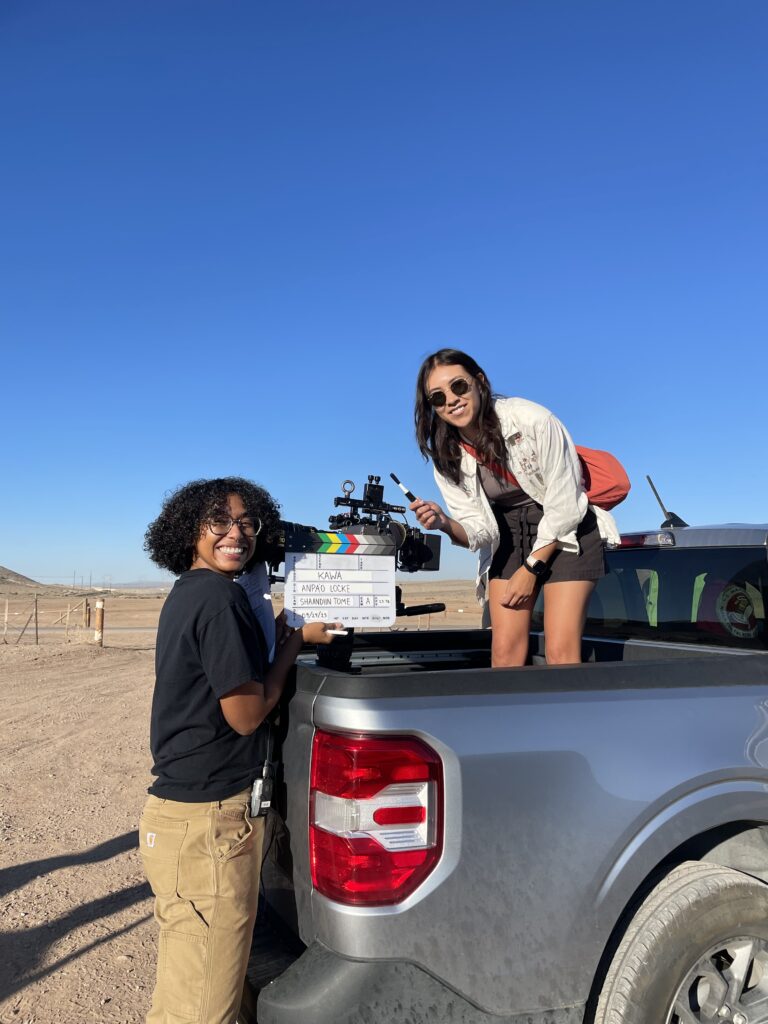
AP: But I think this also opens up a lot of opportunities for taking risks or experimenting or figuring out some of your voice. Especially when you’re working with a lower budget or diving into something that’s incredibly personal or based on incredibly personal stories and stuff like that. Did you find any of it particularly liberating in terms of delving into the story in ways that you maybe didn’t necessarily see before you went in?
AL: There are a lot of instances where before a scene I wrote it literally minutes before. It was on the spot thinking of creative solutions. We definitely ran into a lot of problems and that came with really relying on my community. I was definitely very stressed. I definitely gained a few hairs, but it just really burst in a way that I couldn’t have anticipated.
Having the mentorship really comes in handy, like having Razelle [Benally] and Shaandiin [Tome] and Lejend [Yazzie], my producer, we’re solving so many problems a day. If she wasn’t there, I don’t know what would happen. If there weren’t any other community members who were just as invested in this story and cared just as much. I feel like I came out of the hospital room, like I just birthed a baby.
AP: Yeah, it’s cool that you mention that. There’s that idea that each film is your own different baby and they have their own lives that they go off on to. I know you’d mention Lejend as well as Shaandiin who are both also Full Circle alumni just like yourself. [The Sundance Institute’s Full Circle Fellowship was a program to support the next generation of Indigenous American storytellers. With funding from the Kellogg Foundation, the program supported dozens of Indigenous young adults (18-24) from New Mexico, Michigan, and Mississippi]. I was curious about how you communicate with folks that come from very similar backgrounds to you, to some extent?
AL: At the end of the shoot, I told Shaandiin it means so much to have her because she was my mentor. Then to also have her come in this spot and believe in the project and support me. It meant so much to have her as DP and also a producer. Having Lejend — if anyone wants to hire Lejend hit me up! She is legit the best producer; so multi diverse and able to problem solve. I think having the full circle community really made me believe that this project could be done because I think if it was just me doing this project, at this magnitude by myself, I’m not sure if this could happen. I think what we made was really significant, and I think having those relationships of a Native Sundance community made all the difference because I felt like I could trust them in the roles and I could trust them in their ability to deliver. Beyond that, I knew they understood what I was feeling as a Native woman within this industry.
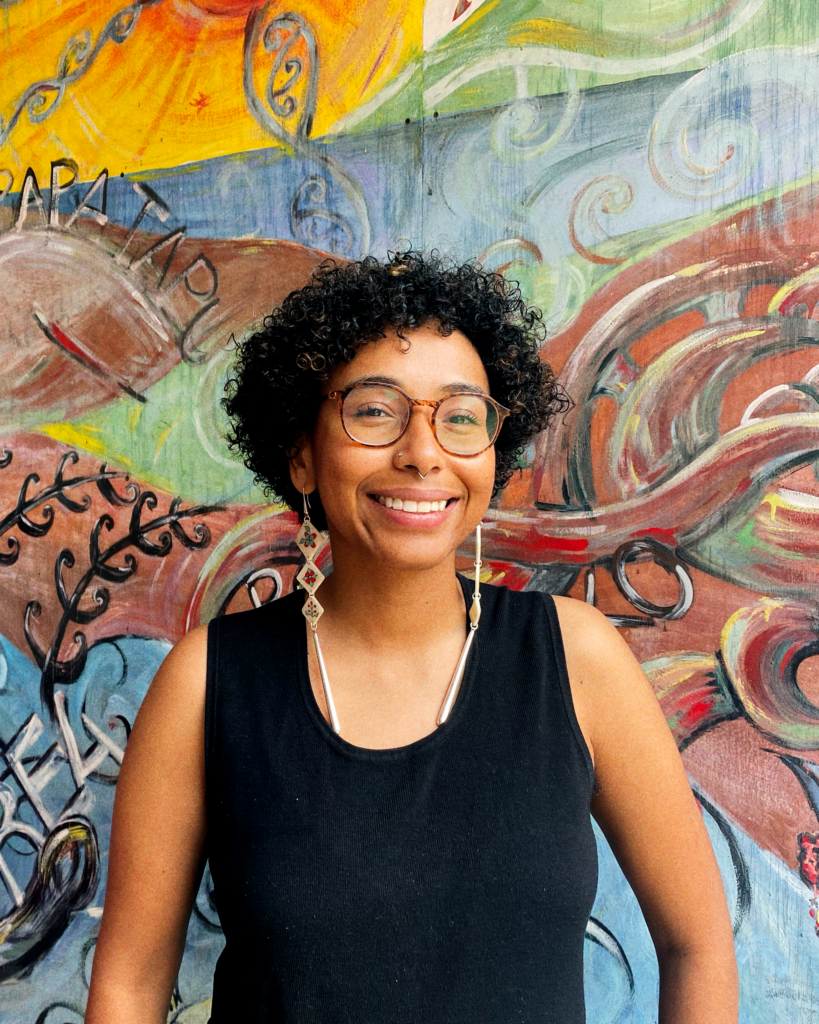
AP: I don’t think this is necessarily just specific to Indigenous artists, but I think that there’s always the pressure or somewhat of like a burden that I think some artists feel specifically from bipoc communities or other underrepresented communities that you have to make the statement on the definitive experience of whichever group you’re from and that it’s also added pressure of having to totally knock it out of the park.
AL: Oh yeah, oh yeah. I felt the pressure.
AP: One of the things that we hope to encourage as well is realizing that there’s a whole sort of spectrum of Indigeneity and what that experience is. In my opinion, to tell an “Indigenous story” is by leaning into their own understanding of what Indigenous is or what it means to them in their own experience. What are some of the challenges or what are also some of the more freeing things of leaning a bit more into your own specific experience versus trying to tell the Lakota story, you know what I mean?
AL: Yeah, yeah. It’s definitely not the Lakota story. If it was, it’d be a lot more traditional, but I definitely was not married to that and I think if I was I would definitely restrict myself a lot more. I feel like just embracing what I know about Indigeneity and my perspective of what it means to be a Native person. It was shaped by my mom, was shaped by my grandma, and like, that’s like strongly my narrative and my understanding of what it means to be Lakota. I only have the Native women really to rely on in my family because the native women in my family lead the shit and are the ones teaching us and are the ones who are making us go through ceremony are the ones who are making us go through all these understandings. And I just wanted to express that aspect and my experience going through that. My experience of being Native is different from other Natives because I’m obviously more black presenting. So I wanted to really showcase that aspect of that story because I feel like that’s what’s been the most integral.
AP: Now that you’re on the other side of production, what’s the big highlight for you in terms of making this film?
AL: Number one: hiring Shaandiin [laughs]. Being able to communicate with her and have her understand what I was looking for and having that relationship with a DP you really respect and you really fuck with. I think the second one is just those instances where I’m thinking through a creative solution. I think a problem came up when one of our locations fell through. So I had to think of something else and that turned out to be such a better thing. Having instances like those where I’m just like, wow, somehow even though we ran through a problem, it was still for the better, it still worked out.
Also having to, like, unclench a little, not be as stressed. I feel like I need someone to take the logistics away for me so I can focus more on the creative. I think that’s my breakthrough now that I’m at the end.
AP: We kind of talked about it a little bit before that idea that each film is kind of like it’s your baby, your own kid to some extent. I also feel that in making films there’s a certain part of it where the film starts to make itself in some regard and it almost communicates to you in some weird way about yourself. For you, what was your take away from your film speaking to you about itself?
AL: Let me think about that. I get what you mean. I feel like the old Lakota saying, understanding the value of relationships. I feel like the relationships within the film feel real. They feel like what I experienced and I was totally blown away by that. And then, also having really amazing relationships behind the camera as well. And just thinking how these people are fulfilling me creatively and how these people are doing something I totally didn’t expect and that it turns out to be really freaking awesome. Just like having these really beautiful colors coming up to create a final painting. I maybe started the outline, but everyone came and filled this shit up and made it look really crazy and something that I’m really proud of.




